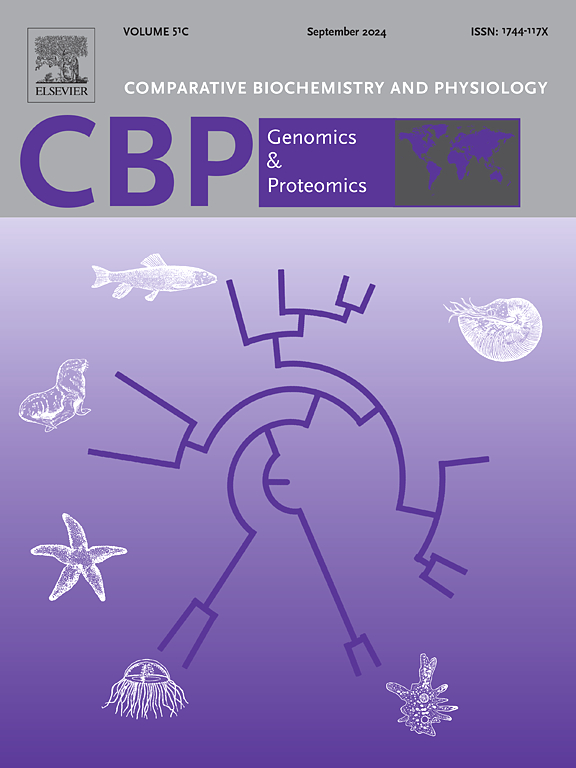A timecourse analysis of gonadal histology and transcriptome during the sexual development of yellow catfish, Pelteobagrus fulvidraco
IF 2.2
2区 生物学
Q4 BIOCHEMISTRY & MOLECULAR BIOLOGY
Comparative Biochemistry and Physiology D-Genomics & Proteomics
Pub Date : 2025-07-09
DOI:10.1016/j.cbd.2025.101576
引用次数: 0
Abstract
Yellow catfish (Pelteobagrus fulvidraco), as an important aquatic species, exhibiting pronounced sexually dimorphic growth patterns. However, the molecular mechanism underlying sexual differentiation in yellow catfish remains a mystery. In this study, we performed histological analysis to identify the critical period of gonadal sex differentiation in P. fulvidraco, Our results showed that the differentiation of male and female gonads did not occur synchronously. The ovarian cavities formation in female occurred at 7 days post-hatching (DPH), followed by the emergence of primordial glandular cells at 25 DPH, whereas male gonadal differentiation initiated later, at 35 DPH. Pseudotemporal analysis was used to infer the developmental trajectories of male and female yellow catfish, highlighting rapid differentiation of individual traits from 7 DPH to 30 DPH. Additionally, timecourse comparative transcriptomic analysis identified several female biased genes, including Foxl2a, Foxl2b, Cyp19a1, zar1l, Rbpms2, as well as chromosomal-structure related genes such as Banf2, npm, Top1b, and H2AA, suggesting a female specific differentiation pattern and ovarian development bias following maturation. In contrast, male-biased genes such as dmrt1 show similar expression patterns in both sexes during the early stage of differentiation, but become male-specific in mature gonads, indicating a regulatory shift from post-transcriptional to expression regulation during sex differentiation. In situ hybridization analysis further confirms the localization of Foxl2a and Foxl2b in early-stage oocytes, and Top1b in early germ cells of mature gonads. This study systematically investigated the early gonadal differentiation process and provided fundamental data for future research on sex determination regulation mechanism in yellow catfish. These findings also offer valuable insight for industrial applications, including single-sex breeding and regulation of ovarian development in Pelteobagrus fulvidraco.

黄颡鱼性发育过程中性腺组织学和转录组的时序分析
黄鲶鱼(Pelteobagrus fulvidraco)是一种重要的水生物种,表现出明显的两性二态生长模式。然而,黄鲶鱼性别分化的分子机制仍然是一个谜。本研究对黄颡鱼性腺性别分化的关键时期进行了组织学分析,结果表明雌雄性腺分化并非同步发生。雌性在孵化后7天形成卵巢腔,在孵化后25天出现原始腺细胞,而雄性在孵化后35天开始性腺分化。伪时间分析表明,黄颡鱼在7 DPH至30 DPH期间个体性状分化迅速。此外,时间序列比较转录组学分析发现了几个雌性偏倚基因,包括Foxl2a、Foxl2b、Cyp19a1、zar1l、Rbpms2,以及染色体结构相关基因,如Banf2、npm、Top1b和H2AA,表明雌性特异性分化模式和成熟后卵巢发育偏倚。相比之下,雄性偏倚基因如dmrt1在两性分化早期表现出相似的表达模式,但在成熟性腺中变为雄性特异性,表明在性别分化过程中从转录后调控转向表达调控。原位杂交分析进一步证实Foxl2a和Foxl2b定位于早期卵母细胞,Top1b定位于成熟性腺的早期生殖细胞。本研究系统探讨了黄颡鱼早期性腺分化过程,为进一步研究黄颡鱼性别决定调控机制提供了基础数据。这些发现也为黄颡鱼的单性繁殖和卵巢发育调控等工业应用提供了有价值的见解。
本文章由计算机程序翻译,如有差异,请以英文原文为准。
求助全文
约1分钟内获得全文
求助全文
来源期刊
CiteScore
5.10
自引率
3.30%
发文量
69
审稿时长
33 days
期刊介绍:
Comparative Biochemistry & Physiology (CBP) publishes papers in comparative, environmental and evolutionary physiology.
Part D: Genomics and Proteomics (CBPD), focuses on “omics” approaches to physiology, including comparative and functional genomics, metagenomics, transcriptomics, proteomics, metabolomics, and lipidomics. Most studies employ “omics” and/or system biology to test specific hypotheses about molecular and biochemical mechanisms underlying physiological responses to the environment. We encourage papers that address fundamental questions in comparative physiology and biochemistry rather than studies with a focus that is purely technical, methodological or descriptive in nature.

 求助内容:
求助内容: 应助结果提醒方式:
应助结果提醒方式:


